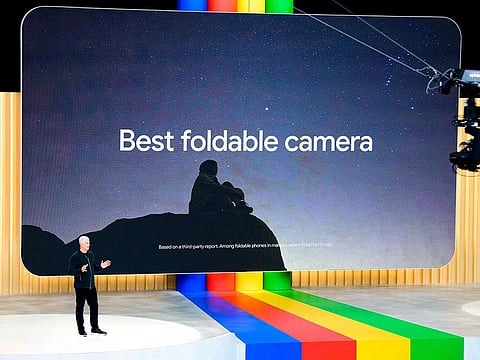Google unveils $1799 Pixel Fold smartphone, a real rival for Samsung
The company also rolled out its first Pixel-branded tablet and a $499 Pixel 7a

Alphabet Inc.'s Google introduced a $1,799 foldable smartphone, a new entry-level Pixel phone and a tablet for the home, its latest attempt to spark hardware sales in an arena saturated by Apple Inc. and Samsung Electronics Co.
Launched at Wednesday's Google I/O conference, the Pixel Fold is Google's first entry into the growing foldables category and comes with a 7.6-inch main display and a 5.8-inch external panel. Google touts this as the thinnest foldable in the markets where it will be sold, which include the US, UK, Germany and Japan.
The company also rolled out its first Pixel-branded tablet and a $499 Pixel 7a, trickling down its 2022 flagship phone's features to a more affordable price point. The three devices use an in-house chip known as the Tensor G2.
The move into the pricier foldables category marks a strategy shift for Google, which has so far focused on undercutting the cost of rival devices. The Pixel Fold is Google's most expensive handset to date, matching the price of Samsung's latest Galaxy Z Fold 4 and including high-end specifications like 512 gigabytes of onboard storage. Samsung remains the sales leader in foldables "- with 79 per cent of the market last year, according to IDC "- having kicked off the category four years ago with the Galaxy Fold.
Foldables make up only 1 per cent of smartphone shipments. IDC estimates shipments will more than triple from 2022, to roughly 50 million units annually, by 2027. That would still be under 4 per cent of the market, but would account for a $42 billion slice because they fetch higher prices.
"Foldables are a pricing dream," said Neil Mawston, director of research at Strategy Analytics. "We predict foldables will account for an outsized 5 per cent of all smartphone wholesale revenues worldwide this year."
In a presentation, Google said that its foldable's distinguishing features are its screen technology and cameras. The company has built a library of AI-powered camera features "- such as its Magic Eraser, which can remove unwanted elements in photos for a neater composition "- that it says make its hardware a leader. Still, Samsung's comparable foldable device has slightly better image sensor specifications.
Foldable phones typically have an external display for quick tasks and can fold open to a tablet-sized interior screen. Google's Pixel Fold is wider than Samsung's latest model, users of which have complained that it's narrowness makes it harder to use. The Pixel Fold also includes features like face unlock, a fingerprint scanner and a promised 24 hours of battery life.
Google boasted that its device's hinge is more durable than those on competing products and that over 50 of its own apps are optimized for the foldable display.
Google is also banking on two more conventional devices as it attempts again to make headway in the hardware market. The Pixel 7a looks like last year's Pixel 7, but uses more basic components and trims back the list of features. Its screen is 25 per cent brighter than the preceding model and has a faster, 90-hertz refresh rate. There's also face unlock, enhanced camera zoom, and a 64-megapixel rear camera, making it one of the more compelling low-end smartphones.
A year after announcing the product, Google shared more details about its tablet. The device's specifications "- including the company's G2 processor, 128GB of storage, 8MP front and rear cameras and hardware design "- are by this point dated compared with rival devices. Its price "- $499 "- also eclipses some iPad models, though the Google device includes a home dock to stand it upright. While docked, the device will be geared toward video watching, controlling appliances and viewing photo slideshows.
Sign up for the Daily Briefing
Get the latest news and updates straight to your inbox



